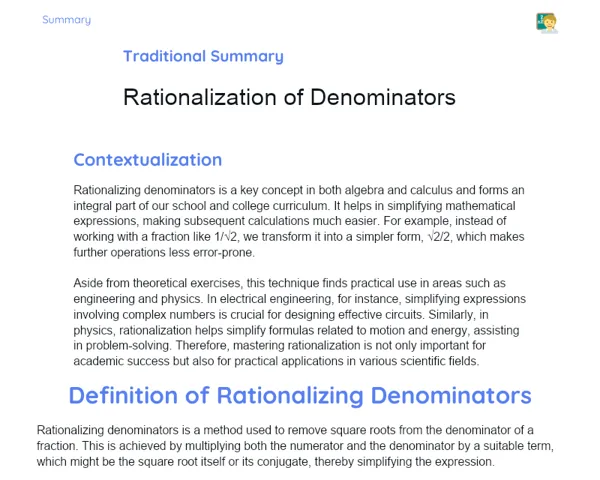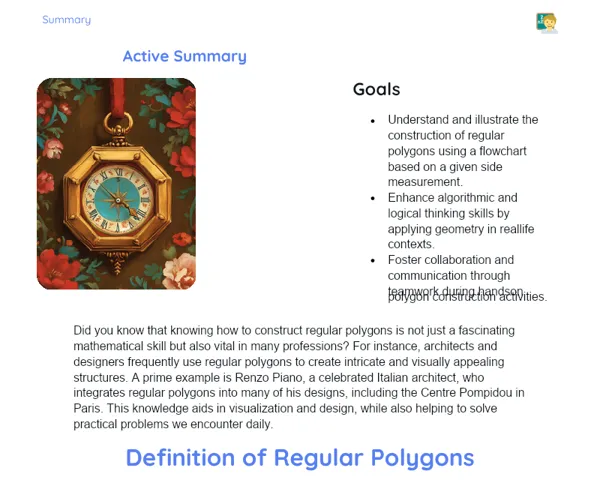Socioemotional Summary Conclusion
Goals
1. Understand the concept of basic first-degree inequalities and their symbols.
2. Develop the skill of solving inequalities using fundamental mathematical operations.
3. Identify and apply the symbols for greater than, less than, greater than or equal to, and less than or equal to in real-world situations.
Contextualization
Did you know that we often use inequalities in our day-to-day lives without even realizing it? 🤔 For instance, if you're saving up to buy a new video game 🎮, you can use inequalities to calculate how much you need to save each month to hit your target in time. Learning to solve inequalities not only enhances your maths skills but also improves your ability to make sound decisions and tackle practical issues effectively!
Exercising Your Knowledge
Concept of Inequalities
Inequalities are mathematical expressions that depict a relative relationship, showing whether one expression is greater, smaller, or equal to another. It's a crucial concept that helps solve everyday challenges involving comparisons and limits.
-
An inequality differs from an equation: while an equation represents equality, an inequality indicates a difference.
-
Symbolism: We use symbols like '>', '<', '≥', and '≤' for greater than, less than, greater than or equal to, and less than or equal to.
-
Utility: Inequalities assist in determining ranges of possible values, which is vital for informed decision-making.
Solving Inequalities
Solving an inequality means identifying the values of x that satisfy the expression. It involves steps like isolating the variable, performing mathematical operations, and interpreting the result.
-
Step-by-Step: Just like following a recipe, solving inequalities has specific steps: isolating the variable, performing permissible operations, and checking the results.
-
Allowed Operations: You can add, subtract, multiply, or divide both sides of the inequality by a number, as long as you keep the inequality intact.
-
Verification: Always substitute your found values back into the original inequality to verify your result.
Practical Applications of Inequalities
Inequalities are incredibly useful for everyday problems, be it in financial planning or time management. You can use them to figure out how much money you need to save for a goal or estimate the time needed to finish a task.
-
Financial Planning: Use inequalities to calculate monthly savings required to meet your financial targets.
-
Time Management: Inequalities can help estimate the time necessary to complete tasks or reach goals.
-
Decision Making: They help you make informed and responsible choices by considering all possible variables.
Key Terms
-
Inequality: A mathematical expression indicating that two expressions do not equal each other.
-
Inequality Symbols: > (greater than), < (less than), ≥ (greater than or equal to), ≤ (less than or equal to).
-
Solving Inequalities: The process of finding values of x that satisfy the inequality.
For Reflection
-
How did you feel when solving an inequality that seemed difficult at first? What steps did you take to overcome this hurdle?
-
How can you apply inequalities to make better decisions in your everyday life?
-
What strategies can you employ next time you feel frustrated while tackling a maths problem?
Important Conclusions
-
Inequalities help delineate ranges of values, which is essential for informed decision-making.
-
Solving inequalities entails isolating the variable, carrying out mathematical operations, and interpreting the results.
-
Inequalities play a vital role in resolving everyday problems like financial planning and time management.
Impacts on Society
Inequalities significantly influence our daily lives. They are essential tools for anyone managing budgets, planning projects, or even shopping. For example, when structuring a monthly budget, we rely on inequalities to ensure that our expenses stay within our income limits. Thus, delving into inequalities equips us to make better and more responsible decisions, aiding in effective resource and time management.
On an emotional level, mastering inequalities can bring a profound sense of achievement and independence. Facing and conquering mathematical challenges boosts our self-confidence and resilience—skills that are vital for navigating life's hurdles. Therefore, as we explore inequalities further, we not only develop our maths abilities but also cultivate crucial social-emotional skills, such as emotional regulation and problem-solving with clarity and composure.
Dealing with Emotions
To help manage your emotions while studying inequalities, we will adopt the RULER method. Begin by taking a moment to sit quietly and reflect on your feelings as you work through maths problems. Ask yourself: 'What emotions arise while solving this inequality?', 'Why do I feel this way?', and 'How can I articulate this emotion?'. After identifying and understanding your feelings, express them healthily—perhaps by talking with a friend or jotting your thoughts in a journal. Finally, think of strategies to better handle these feelings next time, such as taking short breaks or practicing more problems to build confidence. Remember, managing your emotions is a skill that gets better with practice!
Study Tips
-
Practice regularly: Dedicate time each day to solve inequalities. Consistency is key to honing your skills.
-
Incorporate real-life examples: Create inequality problems based on actual scenarios, such as budgeting or planning your day. This enhances understanding of how inequalities apply in daily life.
-
Study in groups: Collaborating with peers makes studying enjoyable and motivating. You can tackle problems together and explore different solution methods.



